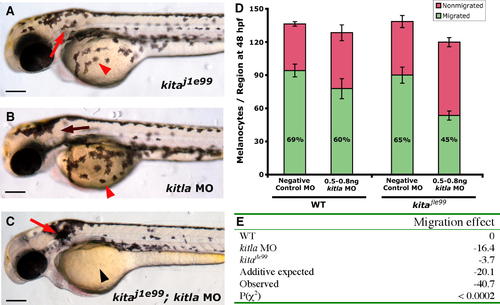
kitla MO Enhances Temperature-Sensitive kitj1e99 Allele (A) kitj1e99 embryos reared at 28 °C appear similar to wild-type melanocyte pattern (see Figure 4A for wild-type) at 3 dpf. (B) A submaximal dose (0.5 to 0.8 ng) of kitla MOs shows little effect in wild-type embryos. (C) Submaximal dose of kitla MOs shows a significant migration phenotype in kitj1e99. (D and E) Quantitative analysis of kitj1e99–kitla enhancement. Melanocytes were counted at 3 dpf and scored as migrated if in green regions or nonmigrated if in regions shown in red (Figure 4H). Mean values with 95% confidence interval are reported (n = 10). (D) Using this metric, wild-type embryos average 94.4 (69% of total) migrating melanocytes. A submaximal dose of kitla MOs results in 16.4 fewer migrated melanocytes than wild-type. kitj1e99 embryos reared at 28 °C have 3.7 fewer migrated melanocytes. Neither the number of total melanocytes or of migrating melanocytes in kitj1e99 nor the submaximal dose of kitla MOs is significantly different compared with wild-type. (E) Migration effect is defined as the difference in migrating melaocytes compared to wild-type. If the combined effects of kitj1e99 and the submaximal dose of kitla MOs are additive, we expect a migration effect of -20.1 in the kitj1e99–kitla MO larvae (-16.4 ± 3.7). Instead, we observe a migration effect of -40.7. The χ2 test between the number of migrated melanocytes in the kitj1e99–kitla MO larvae and the expected number reveals this difference to be significantly (p < 0.0002) greater than additive. Scale bars: 150 μm.
|

